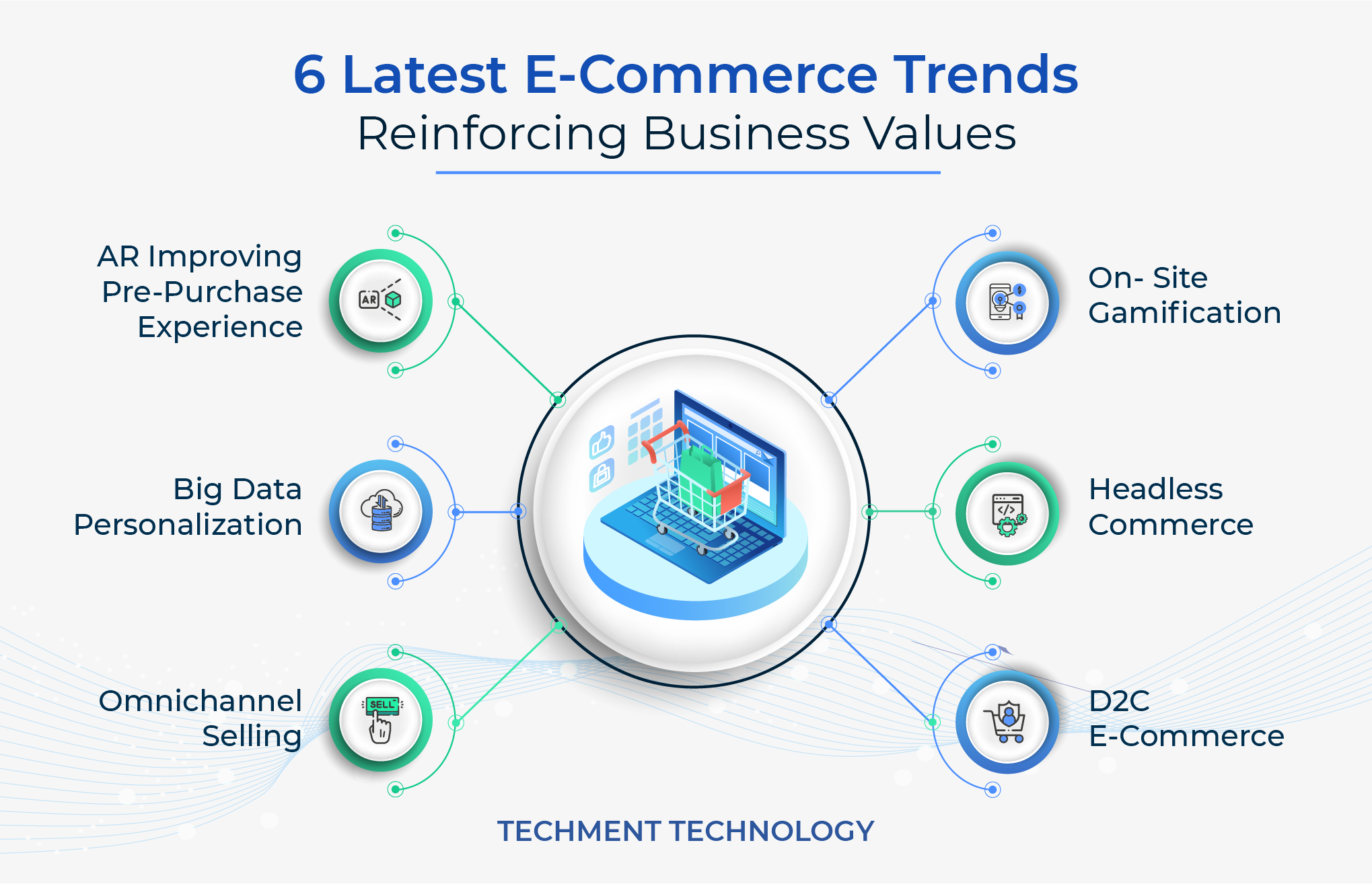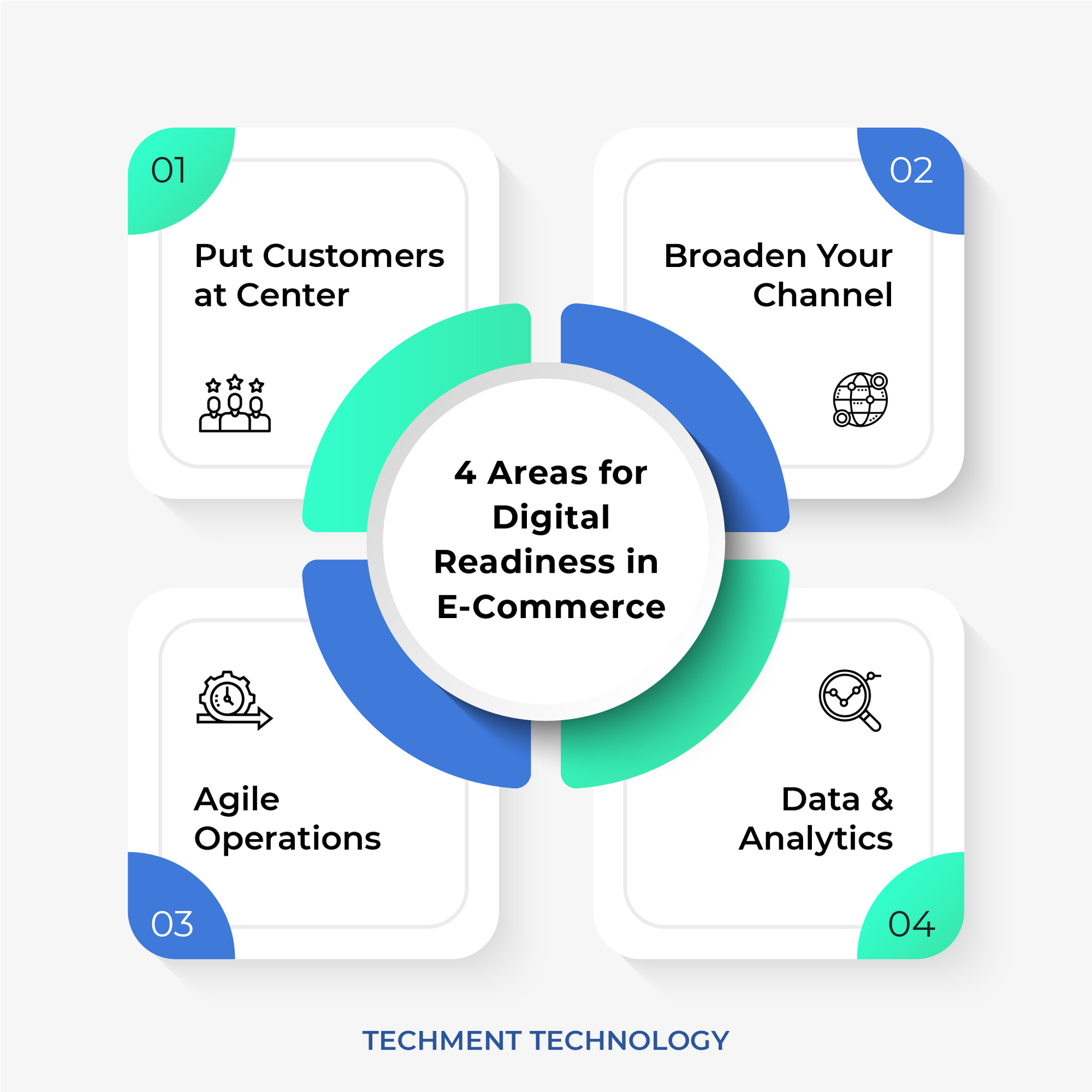After 2020, the lockdown has become the new normal and the digital world has superseded the traditional methods in every aspect of industries and businesses. While product-oriented industries also tried to digitize their work, the service-based industries and especially e-commerce businesses had best utilized this opportunity to come at par with the pre-existing competitors. Consumers rushed towards online channels and companies responded to get a hold of the large customer base.
Now that the connection between customers & sellers has been completely digitized with growing mobile devices and internet ingression; e-commerce has also merged with smart technologies. Industry leaders accept that the changes in business patterns and the adoption of new technologies have been exponential post-pandemic. The global nature of the search, automation of processes, smart interactions, the rise of social media platforms, and companies’ presence in different channels has changed the reality of online shopping.
6 Latest E-Commerce Trends Reinforcing Business Values
The past year has witnessed the development of digital and mobile media. As people turn to devices to fill the social gap, consumers’ demand for personalized shopping has increased. Consumer expectations have influenced many of the e-commerce trends we can see in 2021.
- AR improving Pre-purchase Experience: Now that users are more aware of technologies, they demand a seamless experience in e-commerce too. AR has now become a new mode of advertisement in e-commerce where you can build innovative marketing campaigns using AR, also, connecting them with the brand and its attributes virtually lets customers gain more information about your brand.
IKEA, a furniture shopping app lets shoppers view furniture in their house virtually. This app scans the dimensions of the home and shows how furniture would fit into your house. - On-Site Gamification: E-commerce applied the concept of Gamification to motivate customers to take actions in certain ways in exchange for additional benefits. They usually have three strategies for different customers i.e For beginners they run some contests like free giveaway in exchange for their Mail ID or any contact information.
At the Intermediate level, where customers have provided contact information, they tend to move a step ahead where they find “Spin-a-Win” like contests. This contest is popular in gamification because it is engaging & helps customers reach the next stage quickly. When customers start spending, they are offered some incentive as gratitude from the company.
Nike’s Winter’s Angry Campaign gained wide popularity as users’ engagement to Nike’s site helped athletes to combat winter. This way it promoted winter gears with athletes. - Big Data Personalization: It helps in personalization as this includes regular data like product preferences of customers, search locations, choices, and the types of purchases they do. Also it helps to sell a certain type of product in the same demographic group or analyze the customer behaviour to certain information.
Amazon is the most prominent example of e-commerce that uses big data to enhance the shopping experience of customers. - Headless Commerce: This strategy decouples the front-end website from the back-end website making it easy to make changes when required without disturbing the other processes. Front-end developers make use of APIs to display customer reviews, product details, etc to any screen without any interference from the back-end team.
It is useful when companies want to make instant changes and implement it immediately in the front-end without delay. This has made instant changes & optimization very easy.
Nike, one of the biggest footwear retailers, adopted headless commerce and started gaining more market shares than its rivals. - Omnichannel Selling: It helps shoppers to shop through different channels while they are shopping and brings diversification of channel & data integration in the system.Retailers who can track customers across multiple channels can better serve customers in a more personalized way. This approach enables companies to gain insight into the creation of content and offers to encourage customers to make more purchases.
- D2C E-Commerce: The buzzword in e-commerce these days is D2C commerce which has eliminated the middleman like retailers and has found a direct way to engage customers. This leverages customers with low-cost products and to sellers it provides direct contact which makes them better understand their needs.
Brooklinen sheets reduced the cost of their sheets from $ 800 to $ 99 by adopting D2C commerce.
Hence, understanding the latest retail trends, consumer expectations, design, and technology trends is essential to unlocking your ability to build brand loyalty and attract new customers.

Digital Readiness in E-Commerce to Adopt New Trends
Digital Readiness (DR) in e-commerce can be assessed through the organizational priorities, efforts of companies to adopt new changes with time. DR is what drives a company to be prepared for Digital Transformation (DX). DX has been the hottest topic, especially in E-Commerce companies. According to UNCTAD (United Nations Conference on Trade & Development), global e-commerce has reached $ 26.7 trillion post-covid-19. Based on their research on some countries (which contributed to 65% of Global B2C e-commerce in 2019), online retail sales have grown to 3% (from 16% to 19%) in 2020 as compared to 2019.
A study by “World Benchmarking Alliance” showed that the performance of e-commerce industries in Digital Inclusion was very poor as compared to other tech companies.
For Digital Readiness certain practices and factors has to be considered;
- Put Customers at Center: To get the best results in customer experience, companies must start creating a rich customer profile for the audience of each segment. Customer experience optimization is key to transformation, especially in the e-commerce sector. Knowing about your users’ end-to-end experience, their choices, etc. helps to create a more customer-centric system.
- Broaden your Channel: To resonate with users, companies need to gather information about customers from a variety of channels. While personalizing your e-commerce with new trends, these data can add value and provide an insight as to how to utilize them, so the content deployment to various channels must be consistent and should be impactful.
- Agile Operations: The purpose of transformation isn’t fulfilled only by working at the customers’ end, there has to be agility in internal operations as well i.e., in logistics, inventory, product management, etc. With processes becoming fast and personalized with new trends; the internal operation needs to be equally efficient.
- Data & Analytics: The decision-making process depends on the data and analytics of your company. Collecting data from diversified channels will help in adopting trends like Omnichannel Selling, in D2C commerce among others.
The demographic data, the pain points of customers, their journey through different channels, etc. are key to creating a personalized customer experience and creating brand awareness.

Unlocking Potential Trends for Value Addition
Knowing about the trend which is worth your time and effort is important. While some add tremendous value, others may not be connected to your specific audience, or your business costs might be too high to get a decent return on investment. Many times, to understand which trends are right for you, you need to understand your customers, industry, and competitors.
AI, Automation, Big Data, and other trends have provided better visions to enhance customer experience and added value to businesses. Trends like Headless Commerce allows the bigger stores to apply changes in multiple channels and reflect them in all channels without delay . Omnichannel Selling has the benefit that different units work for a common goal so SMBs can have integrated customer service, inventory, sales, marketing, etc. working for a single goal. Personalization being the soul of goal attainment in e-commerce, is a customer- driven approach which not only gives insight about the customer behaviour but also helps customers to achieve their goal in each stage of their purchase journey. Though it is a popular strategy, most of the businesses are still struggling to utilize it fully. So for companies it’s essential to make the right move and consider several factors before stepping ahead.
For better results, taking consultation from tech partners becomes important because they better know the tech innovations and their behaviors in different platforms.
We provides consultation and solutions based on the latest trends and how they can be clubbed to e-commerce and other businesses.
 All Posts
All Posts